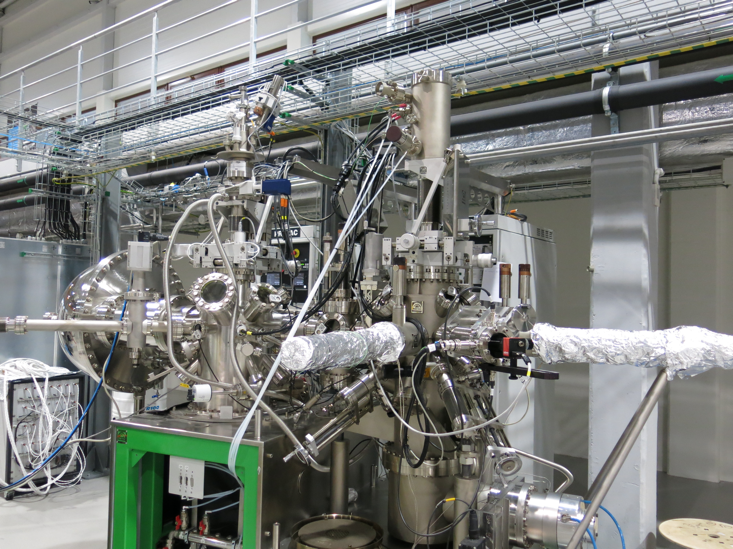Ultra Resolved Angular Photoelectron Spectroscopy
URANOS beamline at Solaris Synchrotron in Krakow
The Ultra Resolved ANgular phOtoelectron Spectroscopy (URANOS, former UARPES) beamline is an experimental installation for studies of the electronic structure of solid surfaces. The beamline is designed for high photon flux, high resolution, variable polarization, and minimal harmonic contamination. The radiation source is an APPLE-II type undulator, having also a quasi-periodic magnetic lattice to suppress unwanted harmonics. The beamline monochromator combines normal (NIM) and grazing incidence (PGM) optics. The experimental end station is constructed of ultrahigh vacuum chambers for sample processing and analysis, as well as devices for sample storage and transfer. Cryogenic, 5-axes sample manipulator is capable of stabilizing the sample temperature in wide range, as well as of precise positioning sample surface for experiments.

State-of-the-art electron energy spectrometer VG SCIENTA DA 30L (with deflectors) is capable of massively parallel recording (30° full cone acceptance without sample rotation) of angle-resolved spectroscopic data. Low energy electron diffractometer (LEED), with a MCP image amplifier, is available for a precise sample orientation and for surface structure studies. The set-up allows for in situ sample processing techniques such as sputter cleaning, thermal annealing, and sample cleaving. Users may attach their own devices for deposition or surface reactions. Sample surface composition and crystallographic order may be monitored during preparation processes in situ, using combined LEED/AES device.
Contact:
Jacek Kolodziej
Tel: +48 12 664 4838 (office) | +48 12 664 4179 (beamline)
Natalia Olszowska
Tel: +48 12 664 4172 (office) | +48 519 078 087 | +48 12 664 4179 (beamline)
Technical specifications
| Source | Elliptically polarizing undulator APPLE II type, quasiperiodic. 21 magnetic periods, period length: 120 mm |
| Photon energy range |
NIM: 8 eV–30 eV, PGM: 16 eV–150 eV, up to 500eV for XPS
|
| Polarization | Linear vertical, linear horizontal, circular, eliptical ,linear skewed. For the linear skewed polarisation the theoretical low energy limit is 12 eV |
| Resolving power (RP) | 20 000 |
| Beam size at the sample (HxV) | NIM: 350 μm x 60 μm, PGM: 270 μm x 30 μm |
| Photon flux at the sample | > 5 x 1011 photons/s @ 20 000 RP |
| Spectrometer slit | Vertical |
| Rotation axes and ranges | Vertical -full 360°, horizontal +30°/-90° |
| Sample temperature during measurements | 8–500 K |
| Electron spectrometer energy max. resolution | 1.8 meV |
| Angular resolution | 0.1° |
| Available sample preparation techniques | Cleaving, thermal annealing up to 1700 K, sputtering, thin film growth |
Sample environment
The URANOS end station includes main analysis chamber, preparation chamber, load-lock for fast sample transfer from air into the ultrahigh vacuum (UHV) environment, and sample storage for 12 samples. The preparation chamber includes LEED/Auger device for surface structure and composition monitoring, an ion gun, and ports for several user devices. When planning your experiment please be aware that:
- Samples must be solid, UHV compatible, flat and not charging under UV illumination.
- Samples must fit a “Omicron type plate” sample holder (Ta, Mo, Cu holders are available)
- Heating may be done with thermal radiation (up to 1100 K) or with electron beam (up to 1700 K ). For the highest temperatures the Ta holder with an orifice (direct sample heating) has to be used.
- The sample mounting is possible on site using Ta clamps welded to Ta holder. Samples that are not rigid enough or too small may be also glued on an epotec glue. Heating in a vacuum will be available for such samples only up to 150°C.
- Sample orientation for the studies is possible using two rotation axis. The azimuthal rotation is not available in situ. If the azimuthal orientation of the sample is important it has to be provided prior to insertion of the sample into the system. At present Solaris does not offer access to an X-ray device for the preorientation of crystals.
- Max. number of samples that can be inserted into a system at a single pumping cycle: 6
- Max. number of user samples that can be stored in UHV: 10
- Experimental plans have to be discussed in detail with the beamline staff.
Detailed information can be found on the beamline’s main page.
-
01.02.2024
X-ray Microimaging and Microspectroscopy
-
21.12.2023
AMS-IRMS for radiocarbon dating



